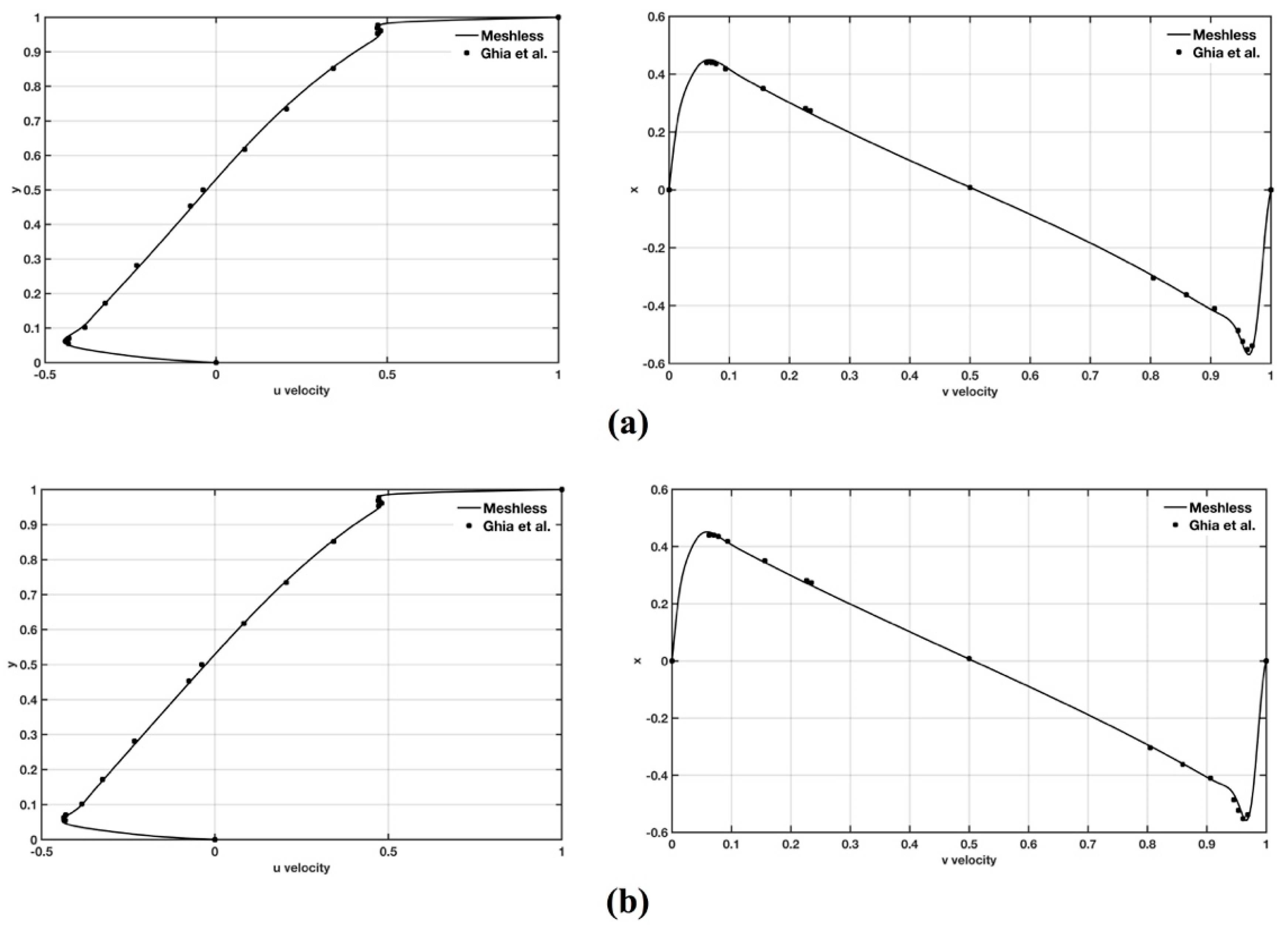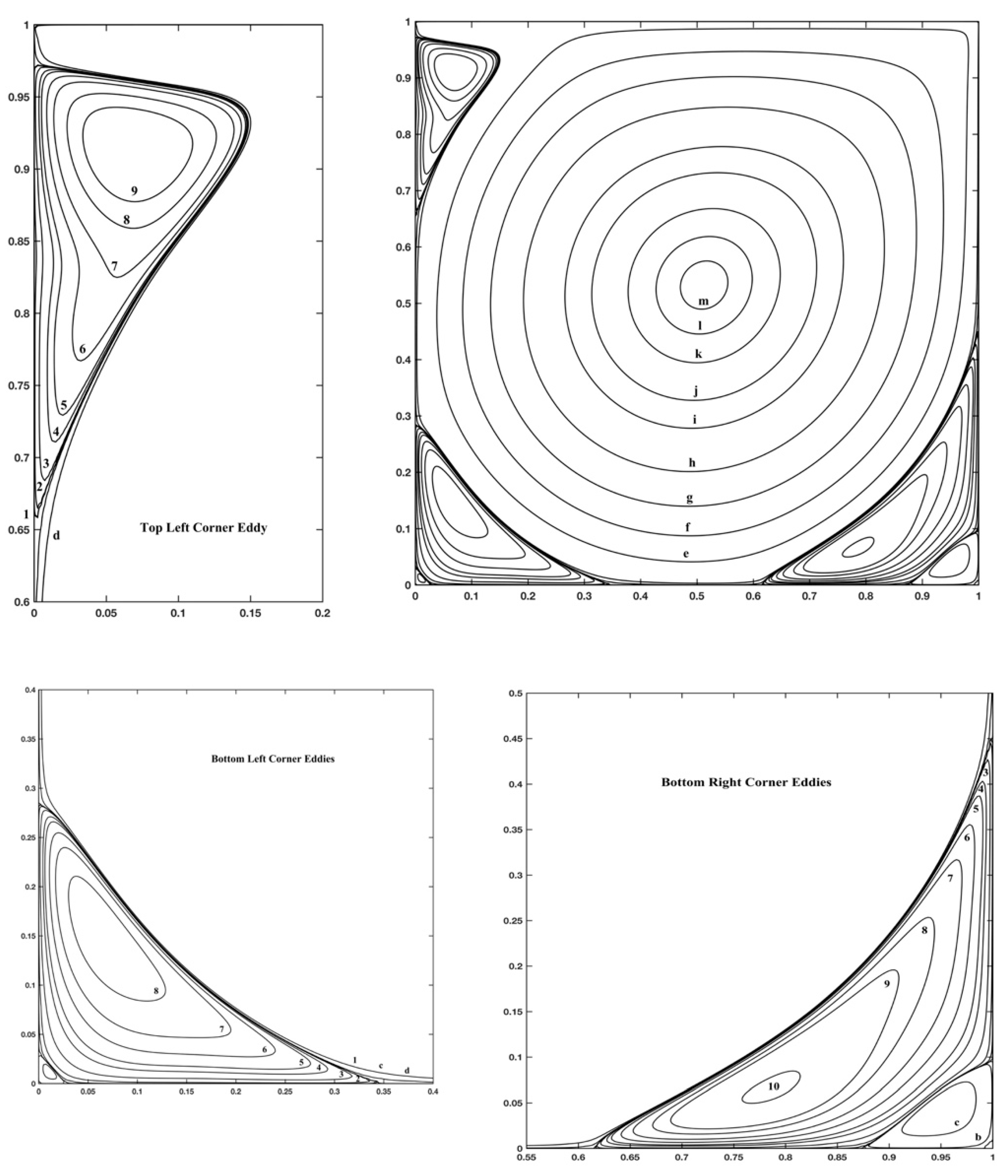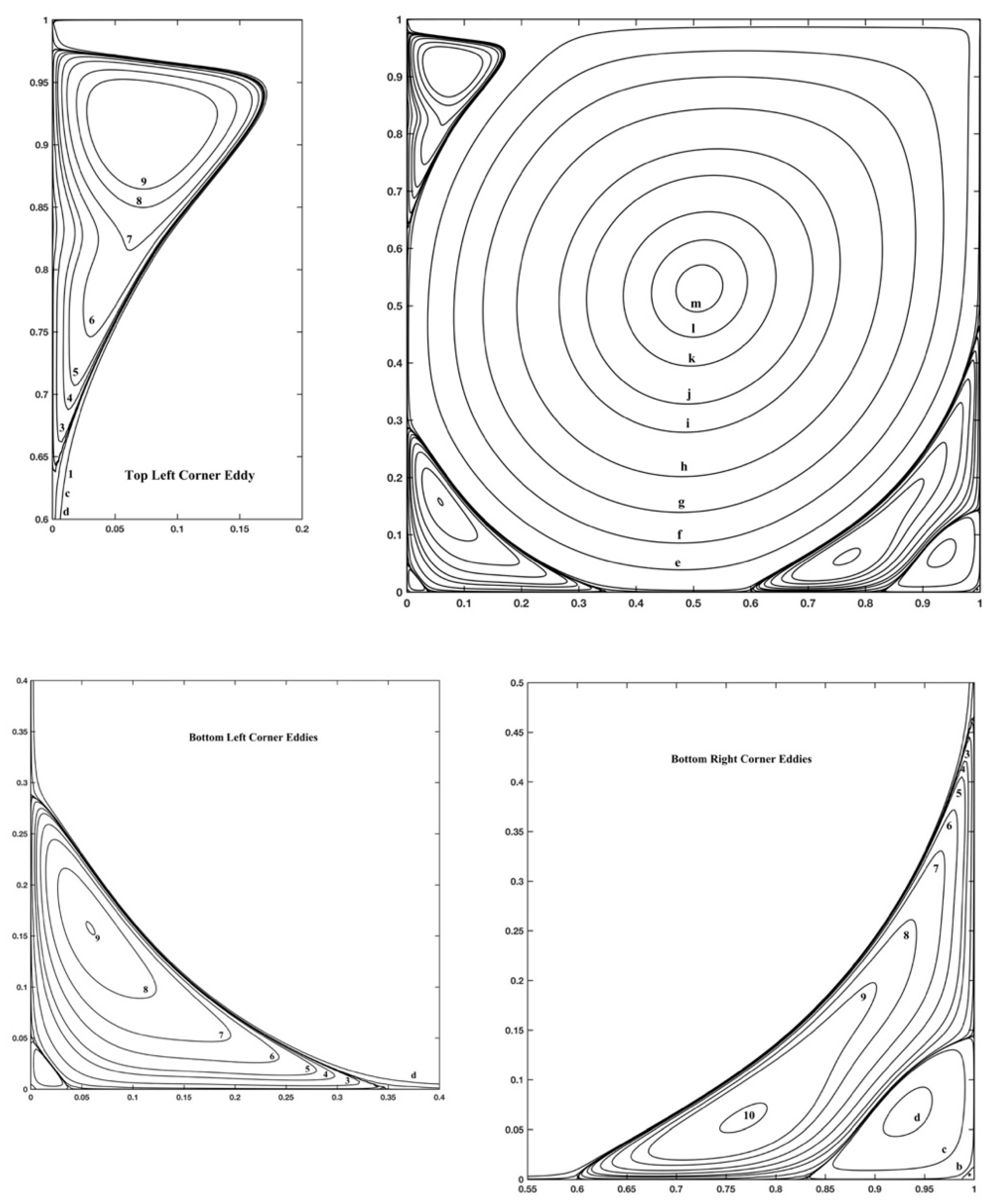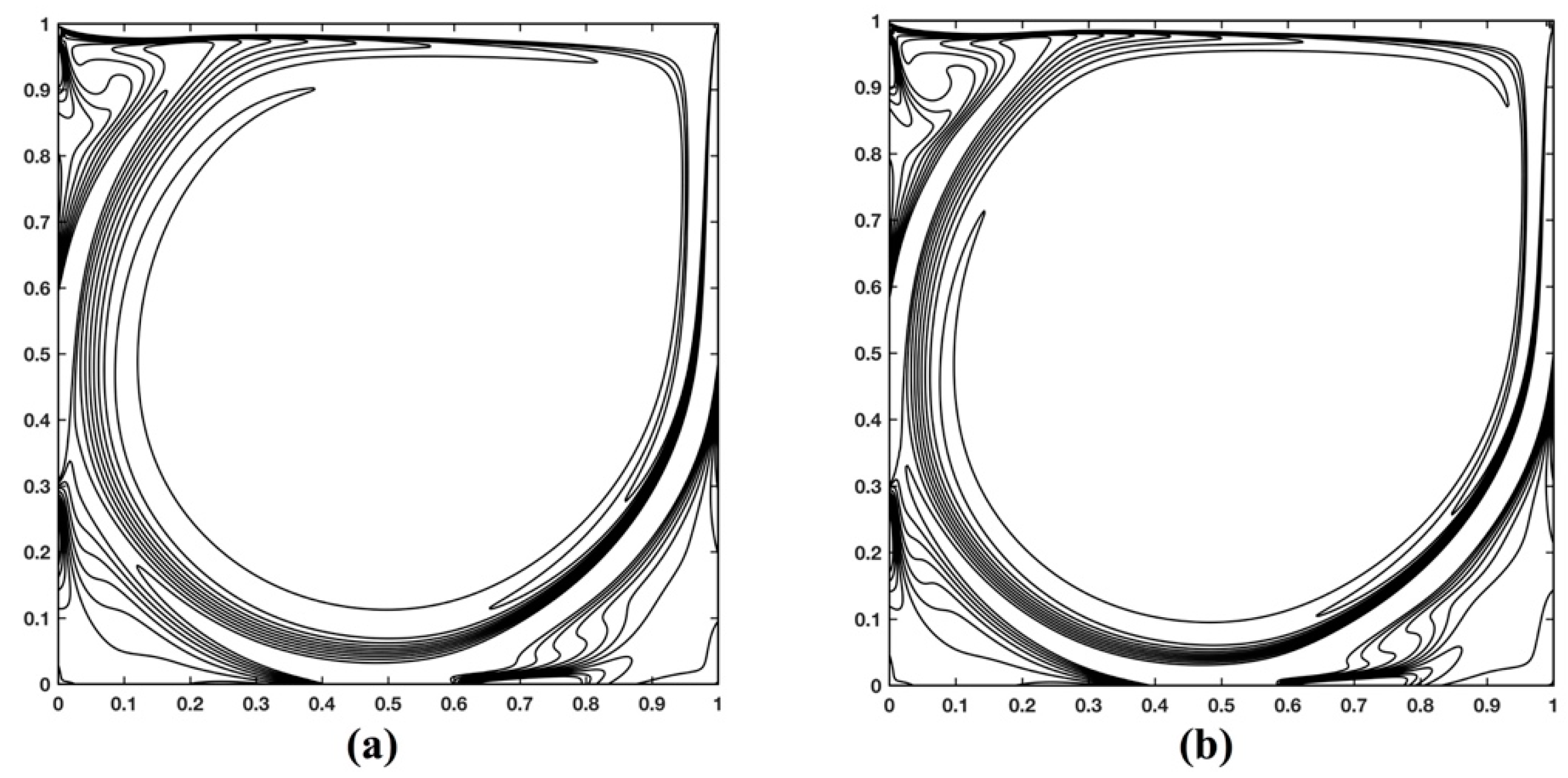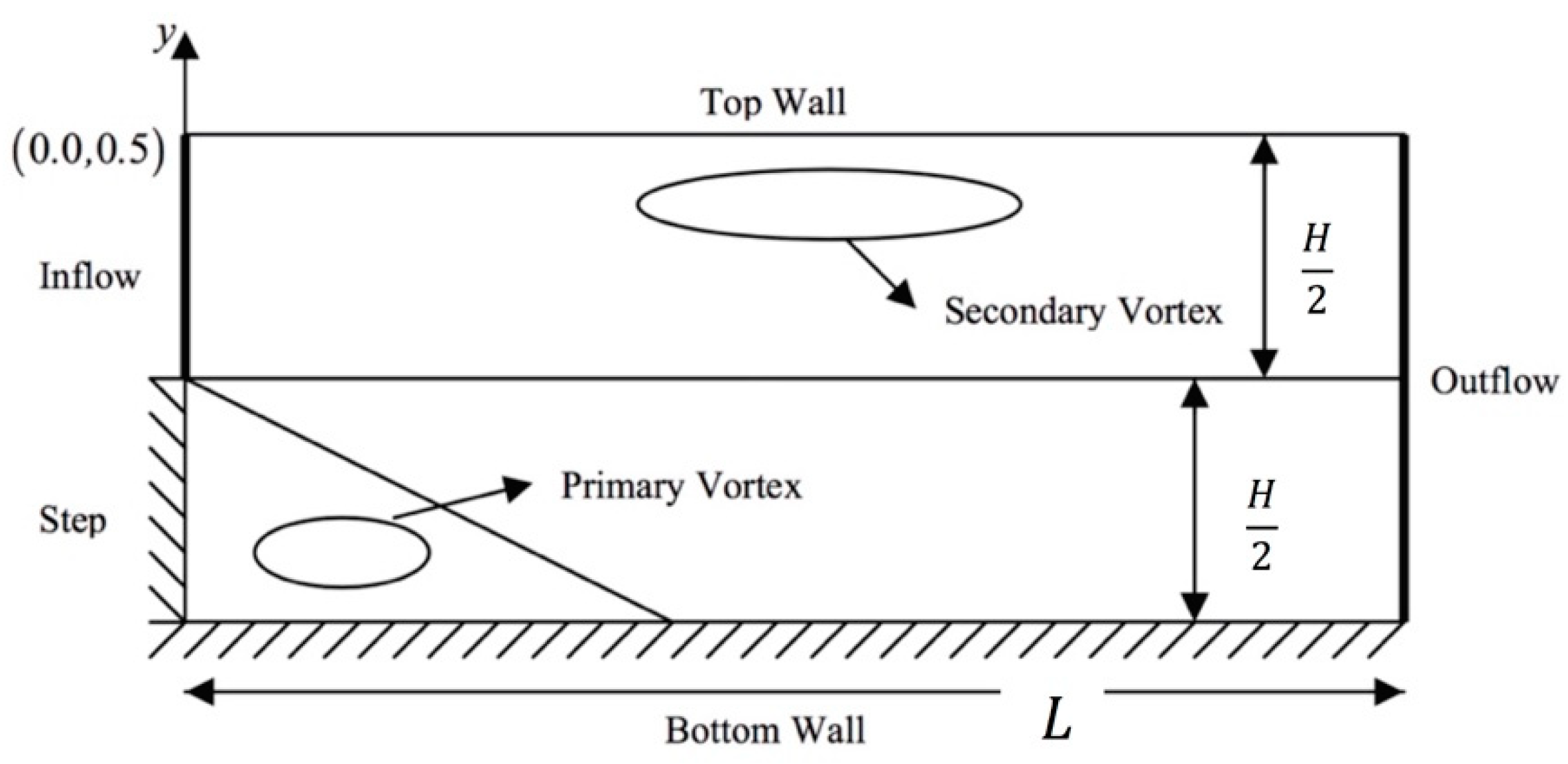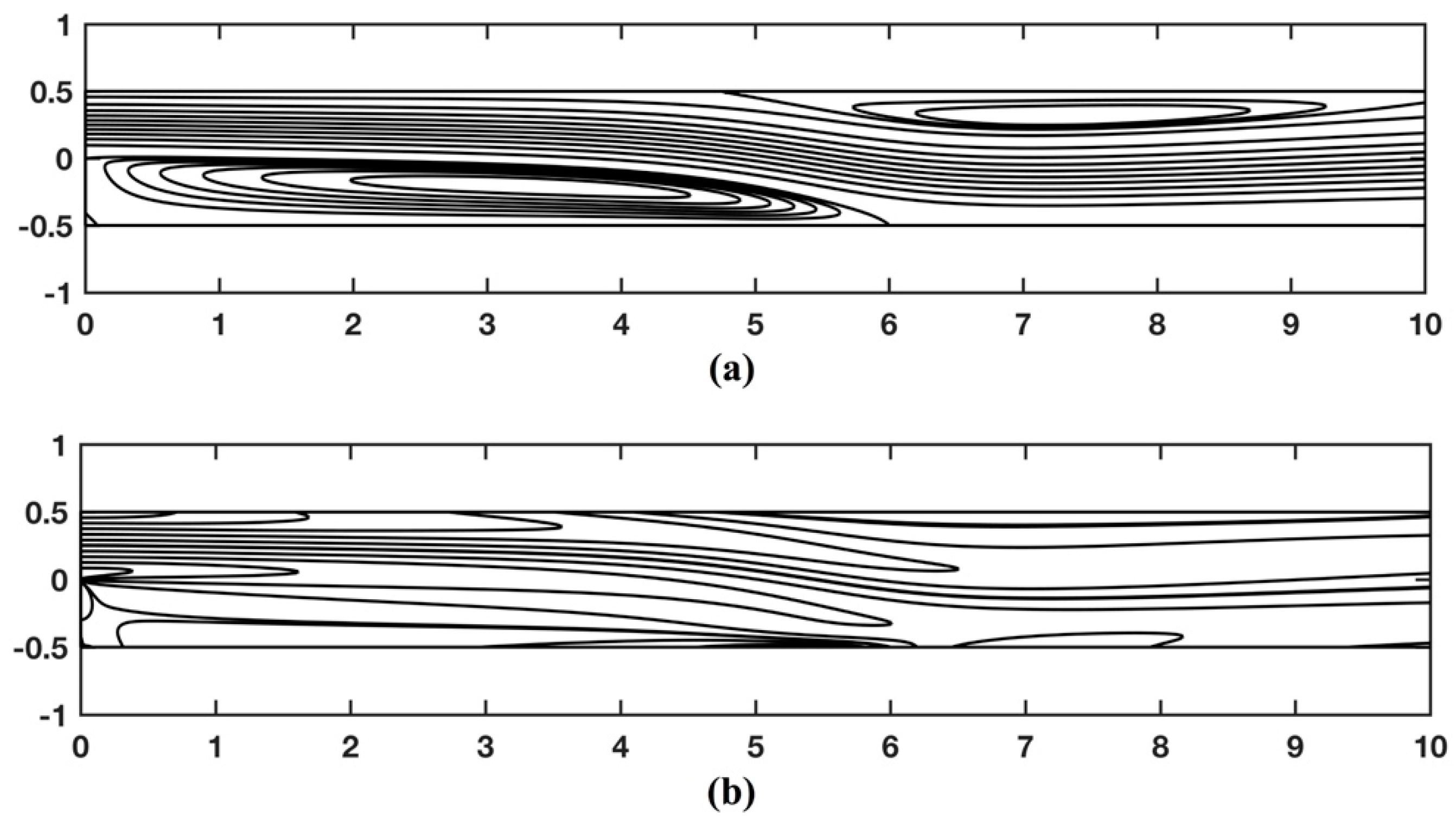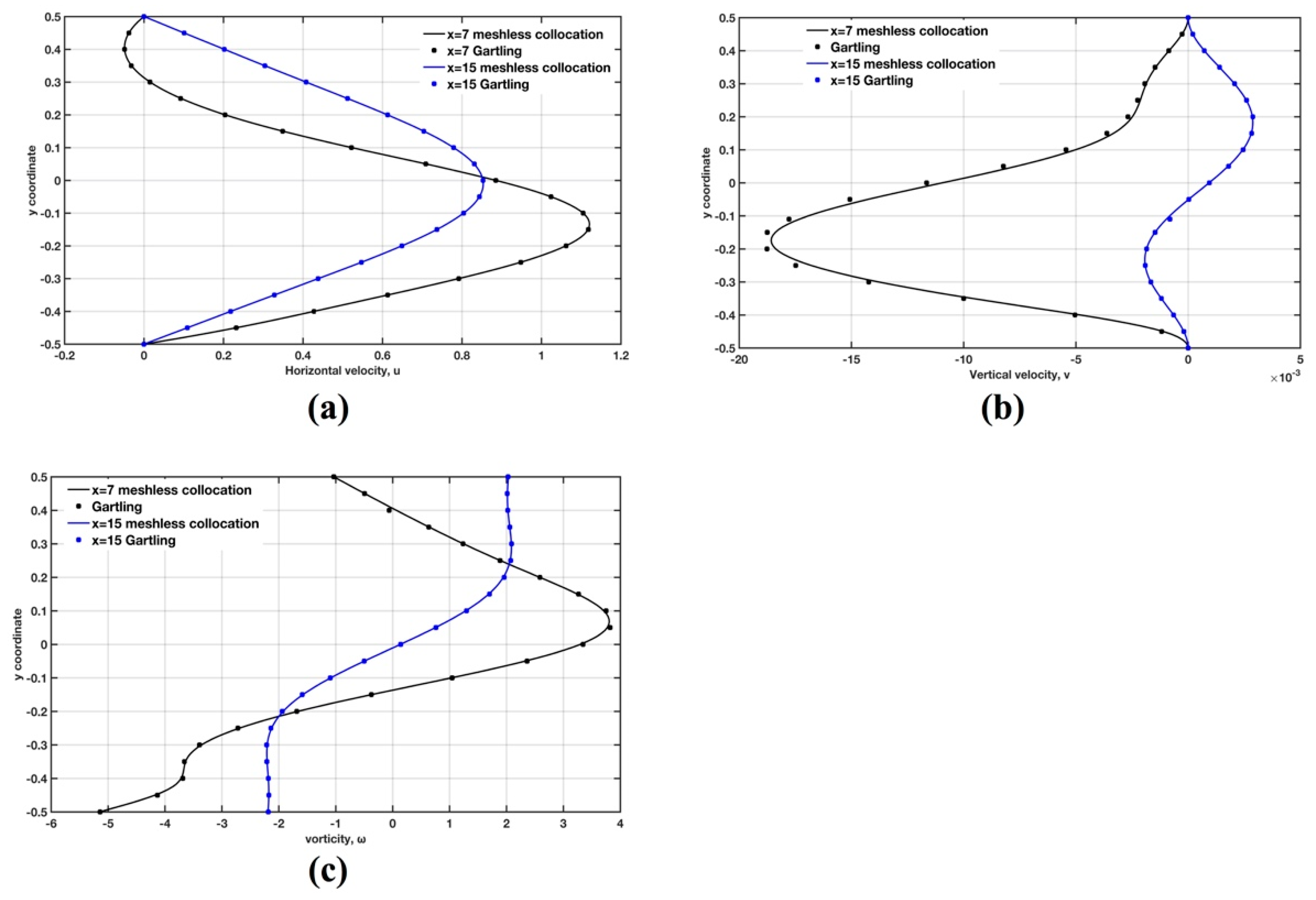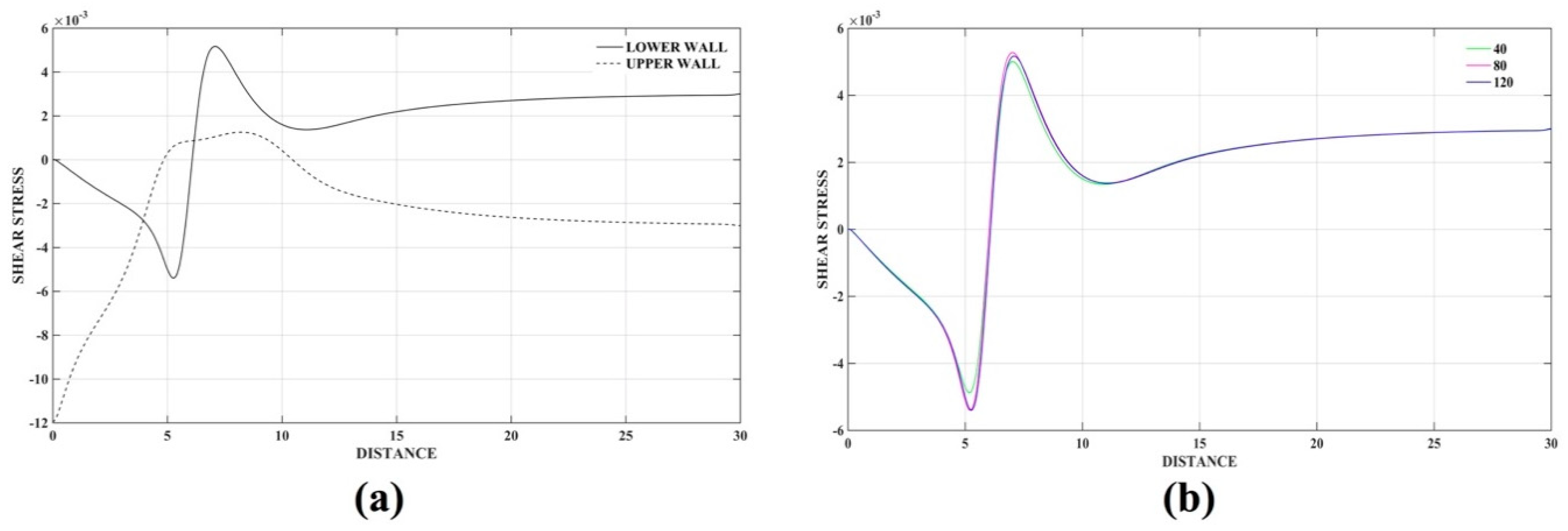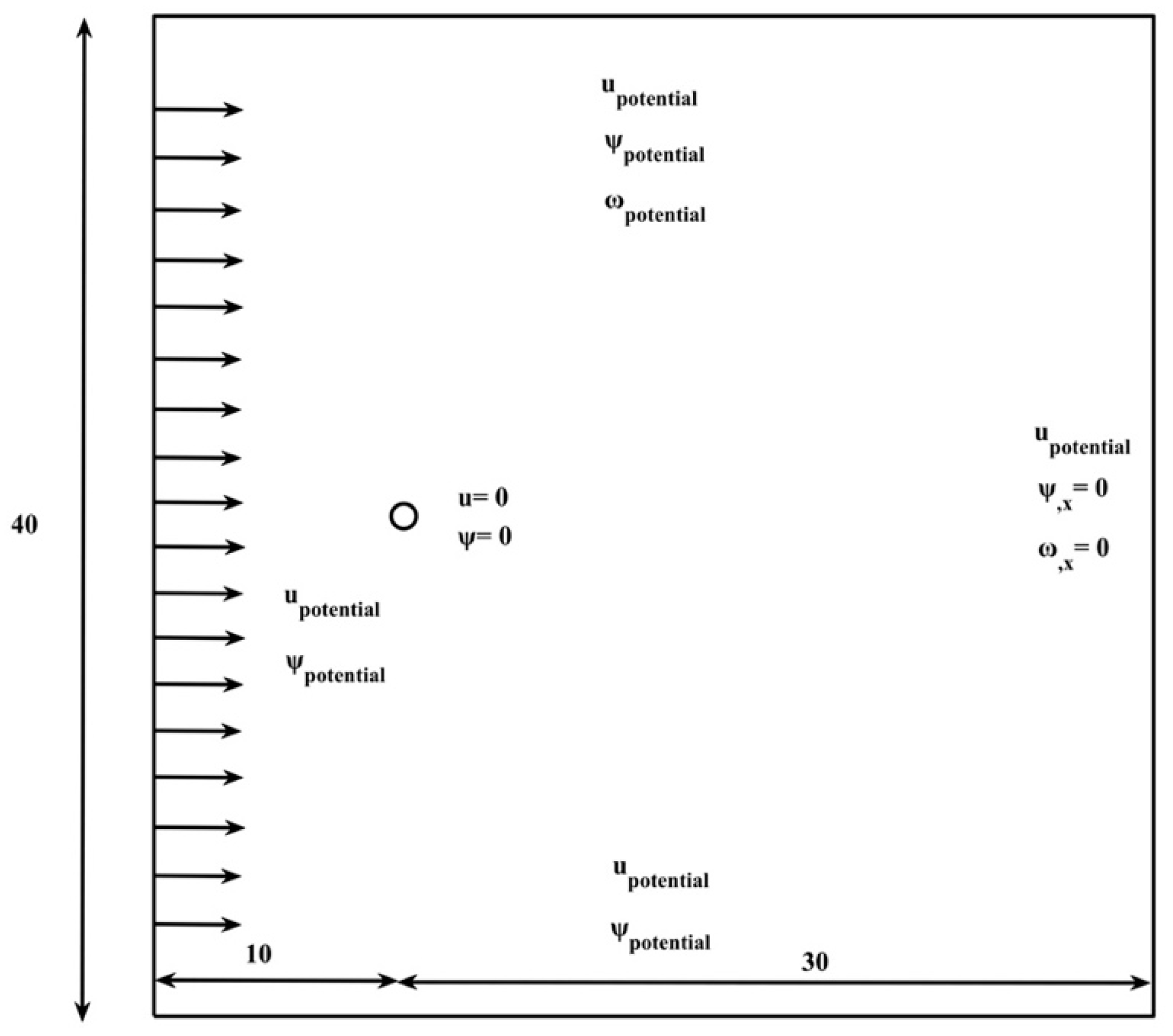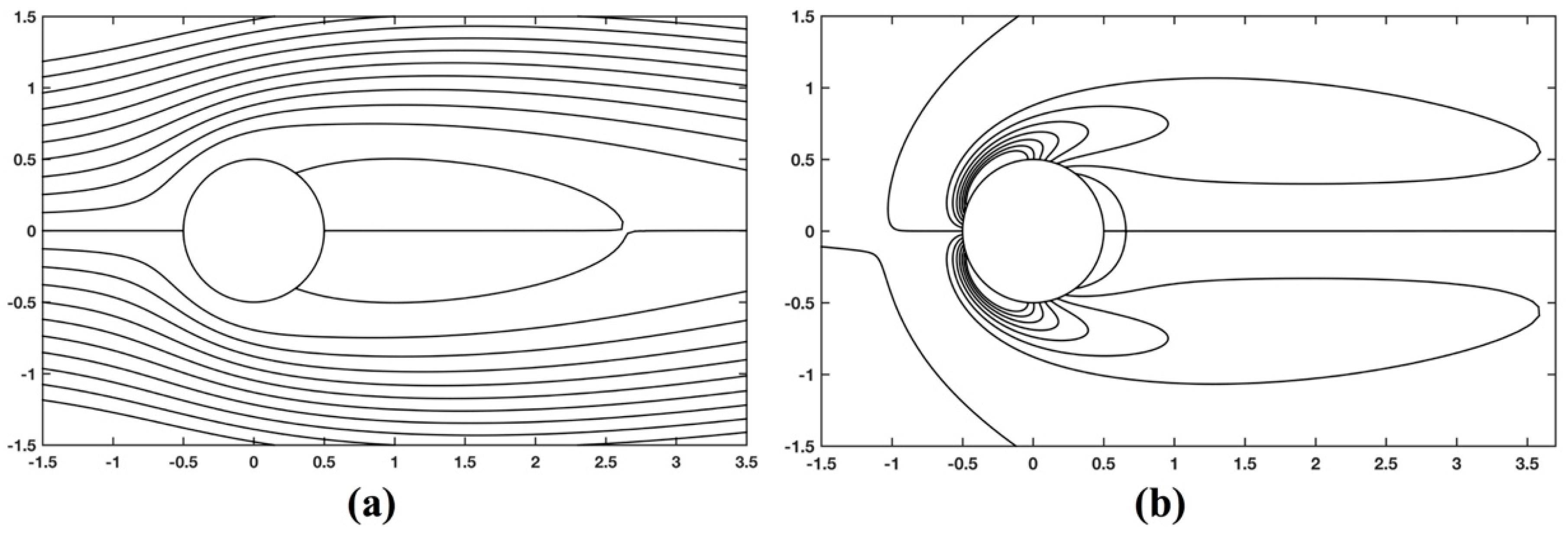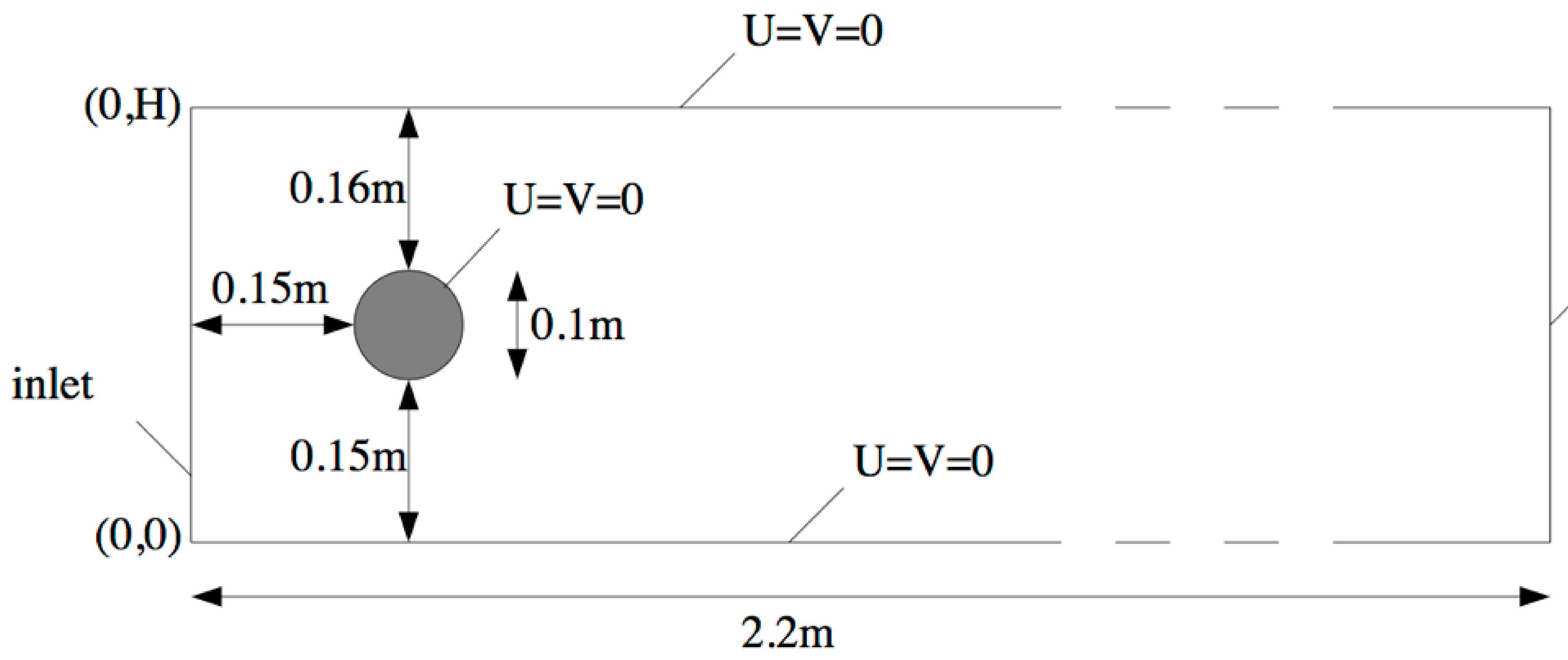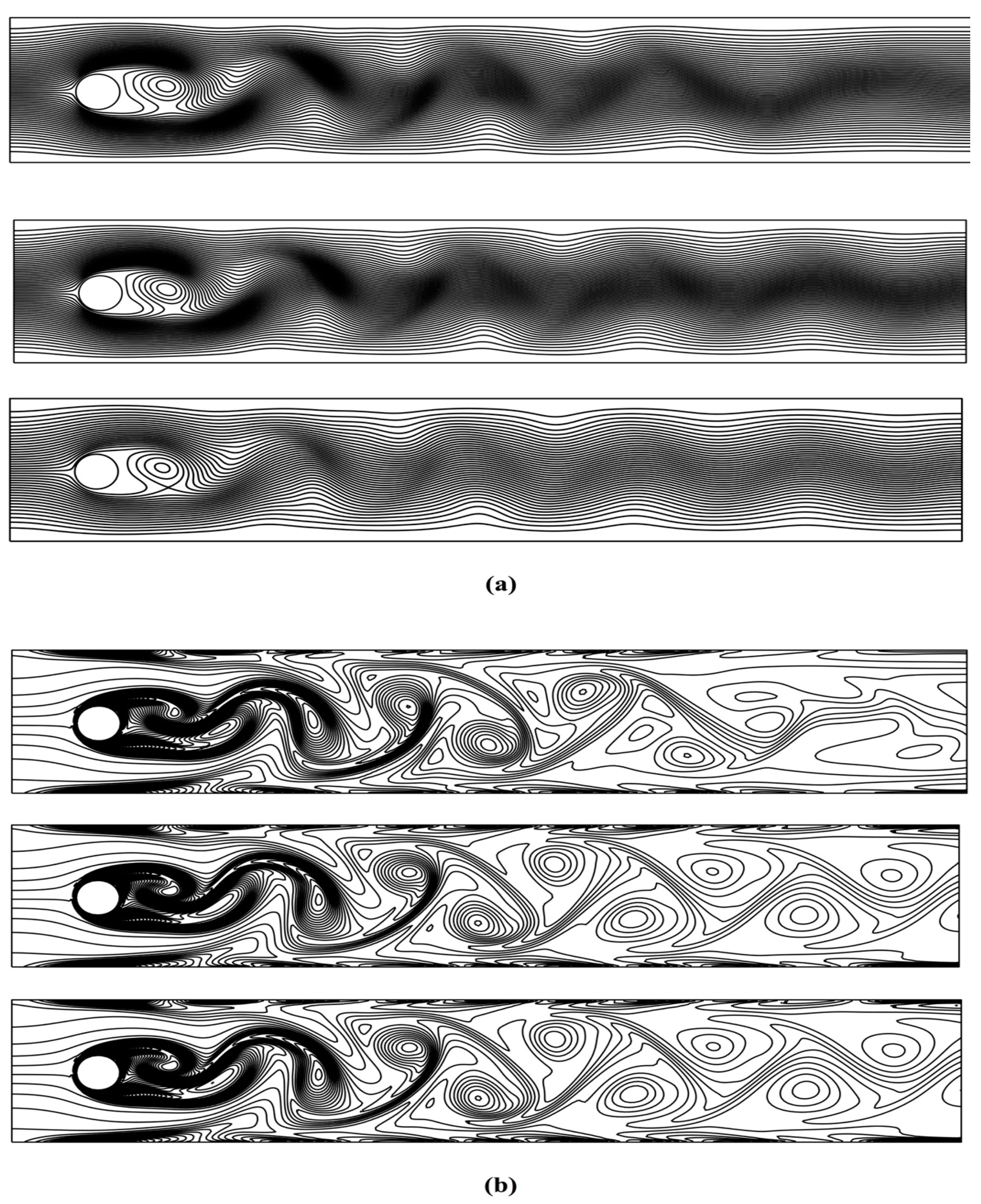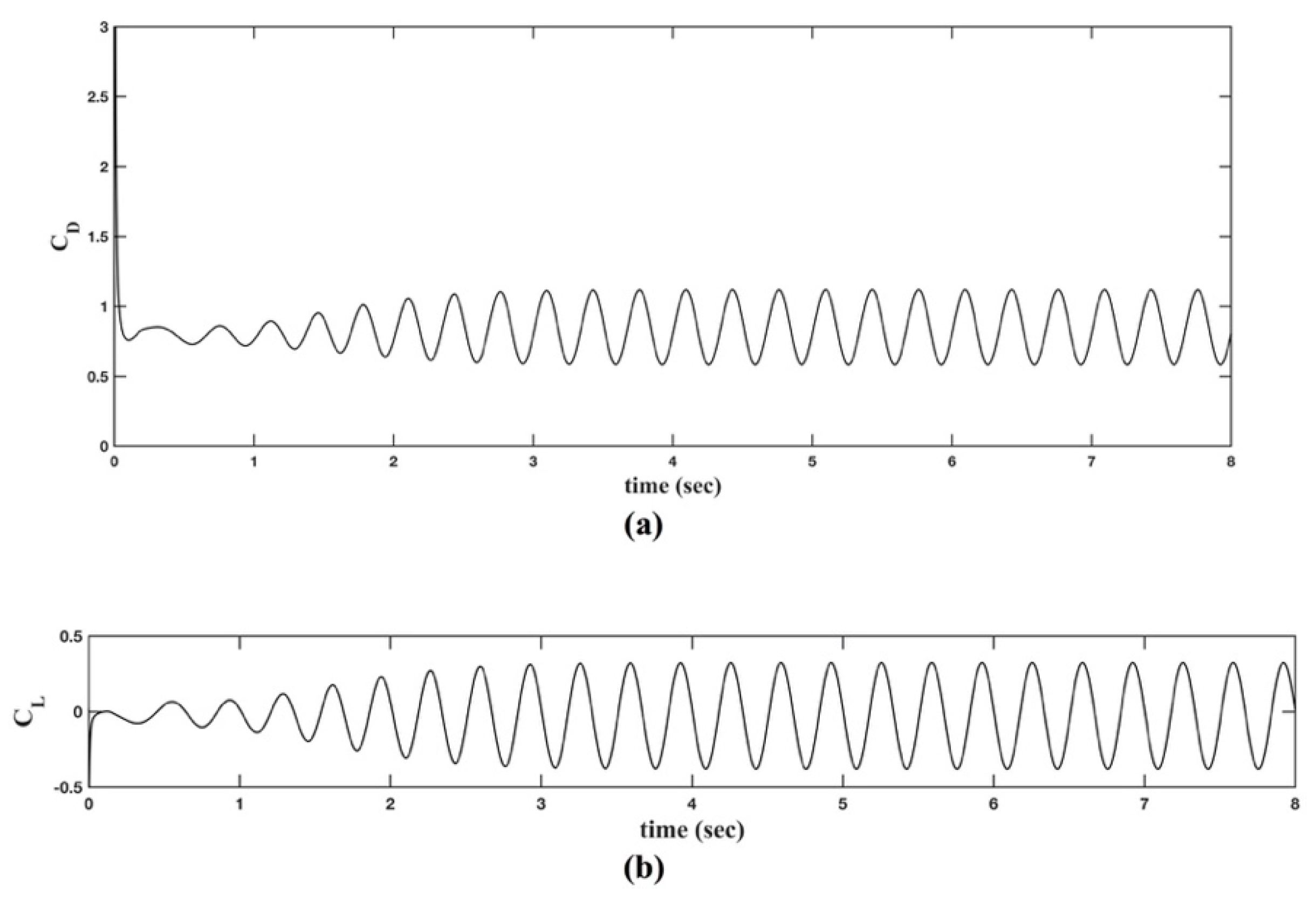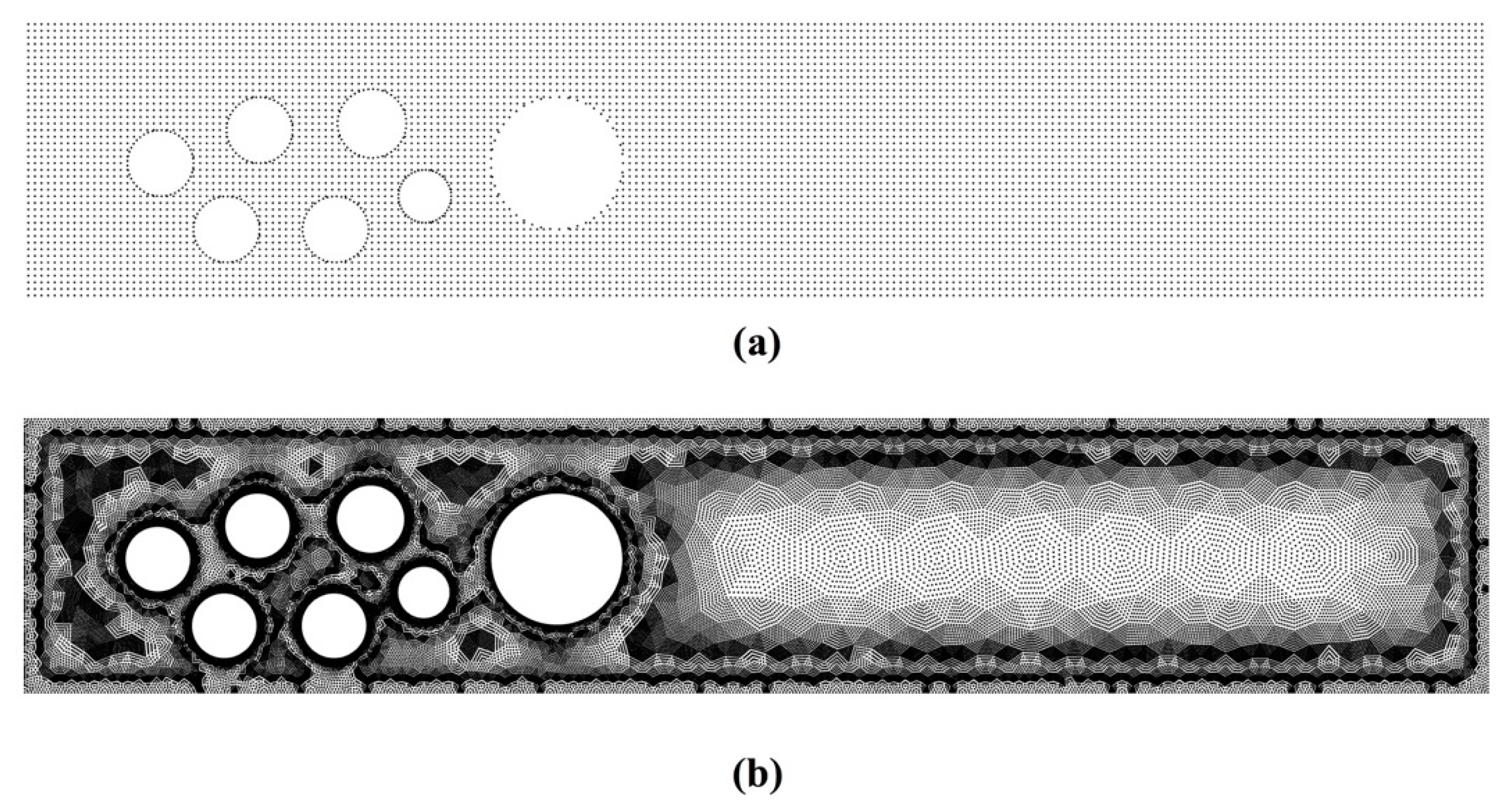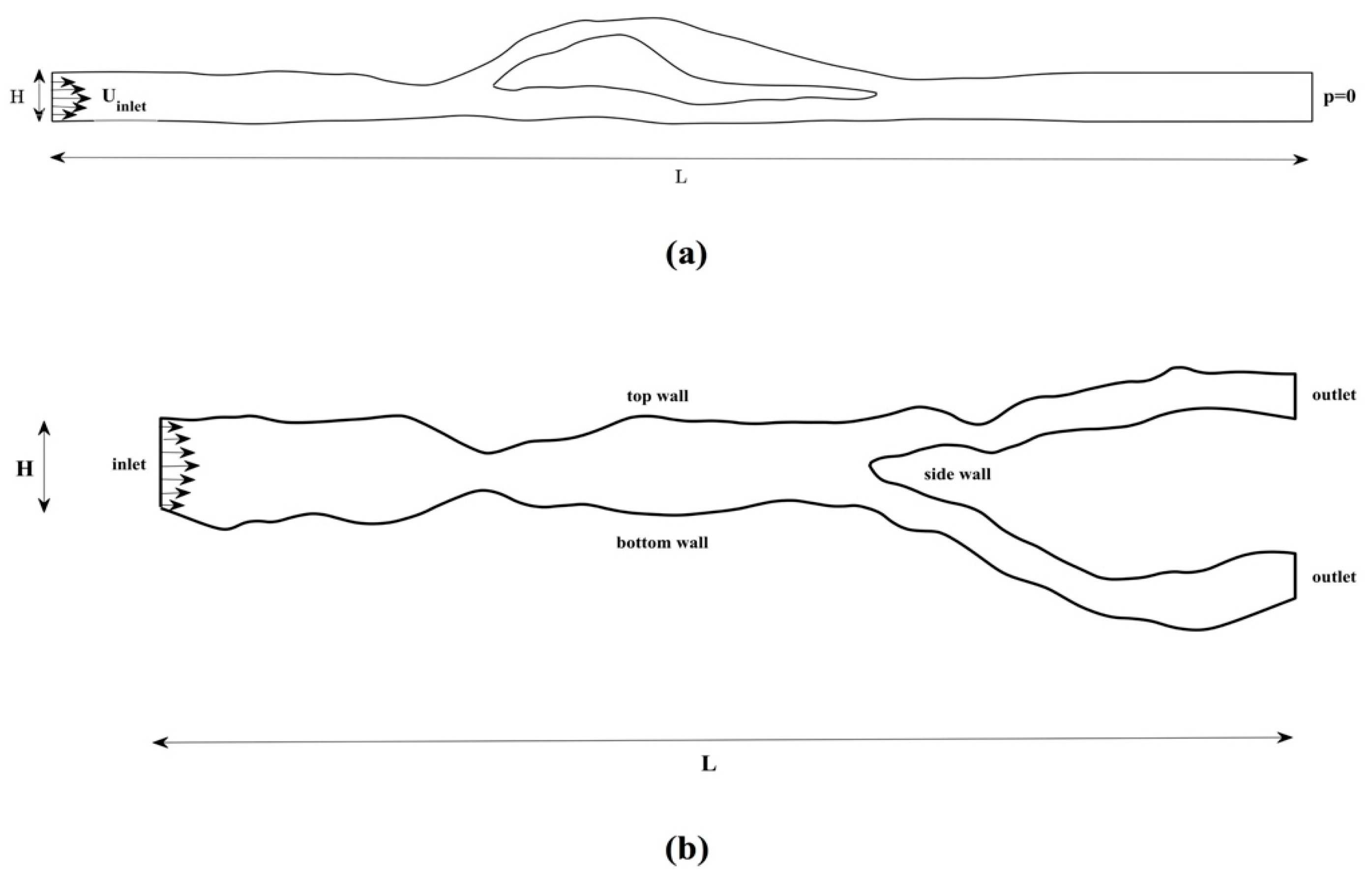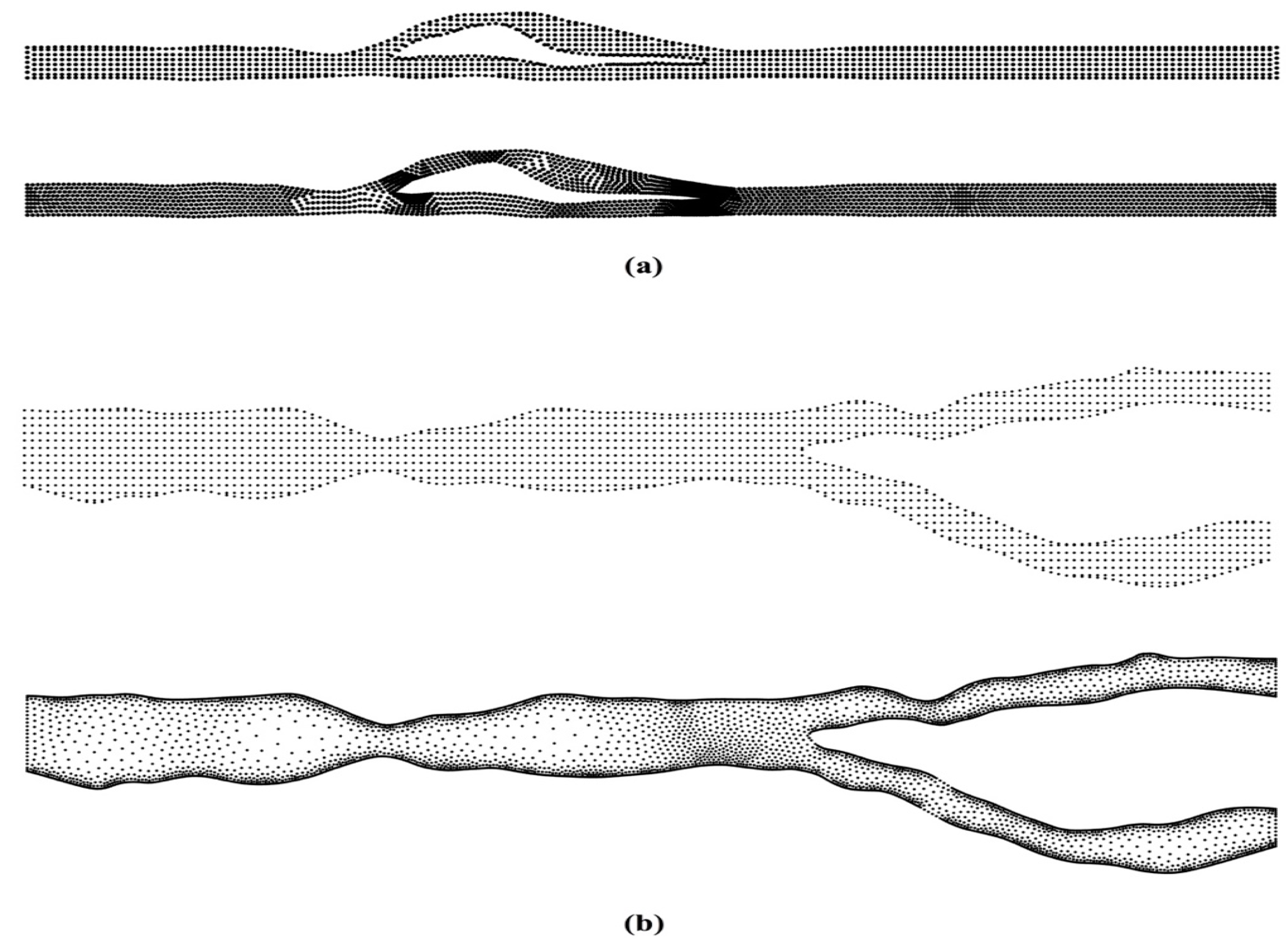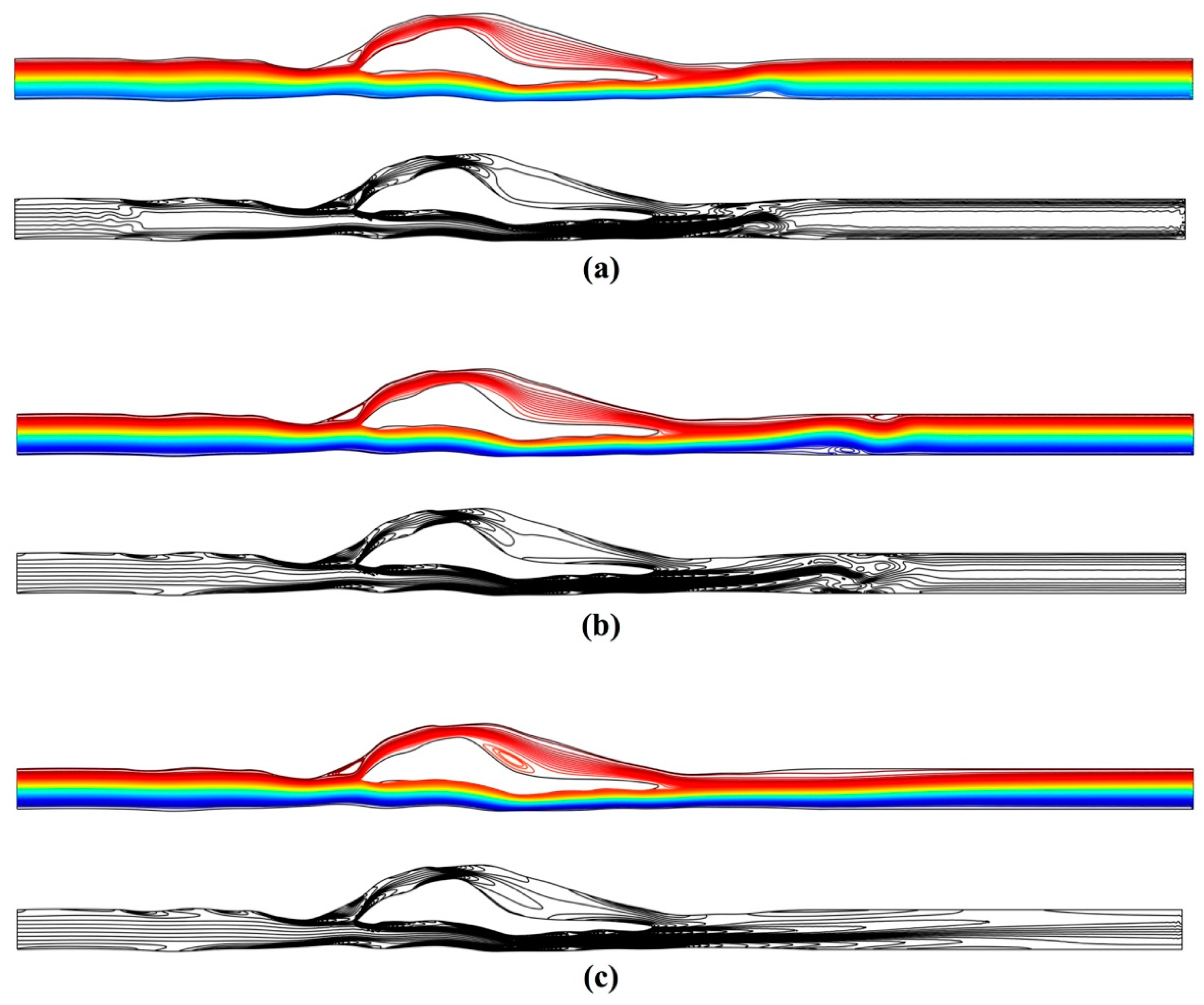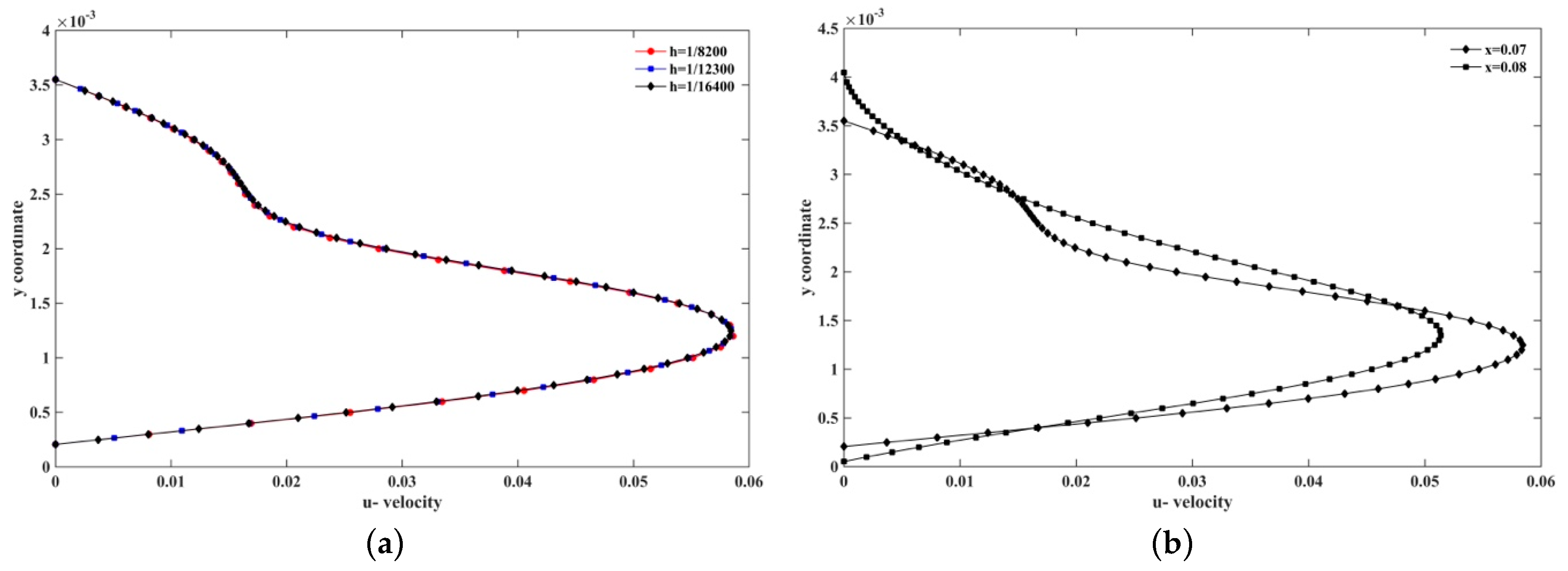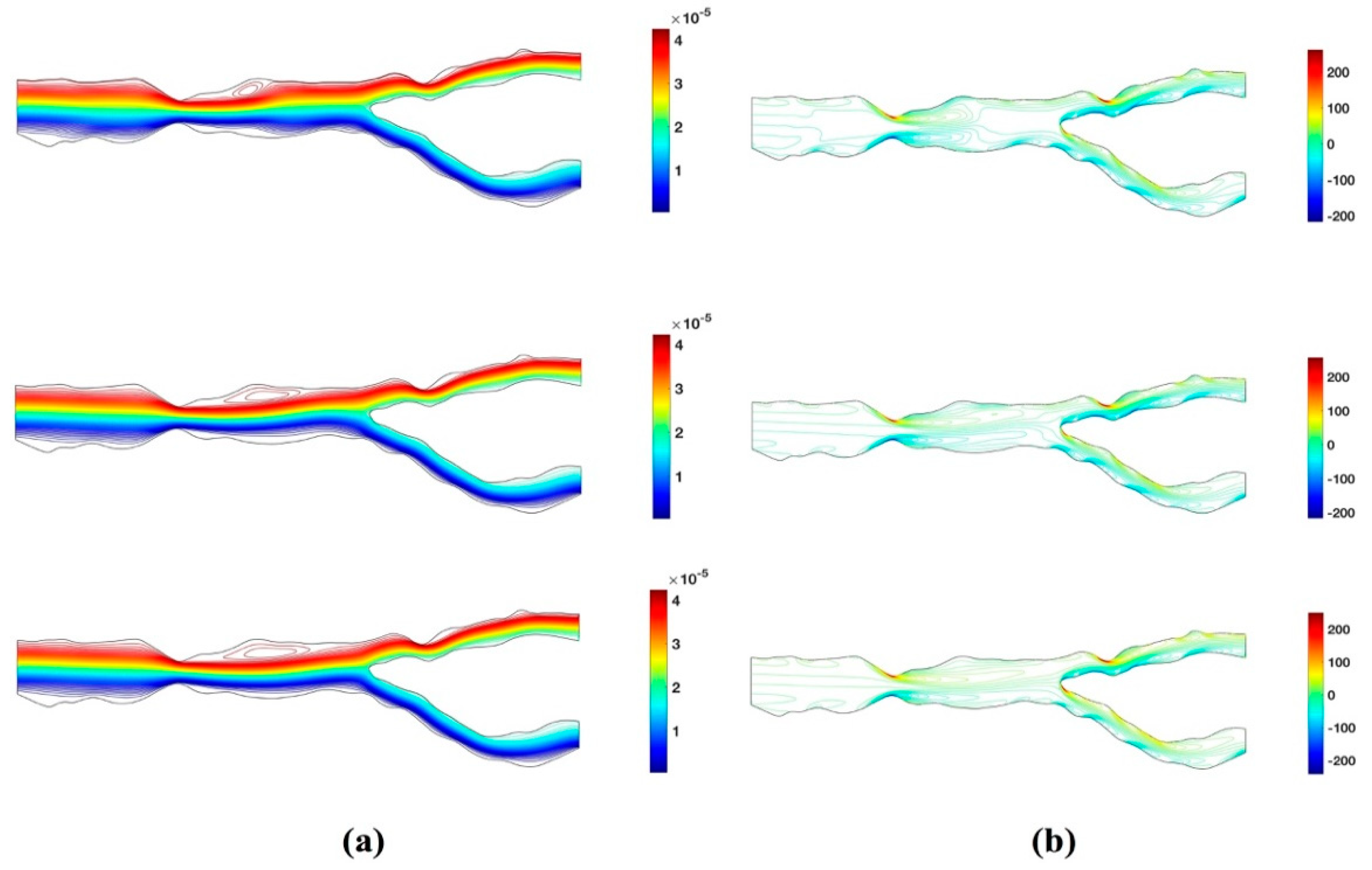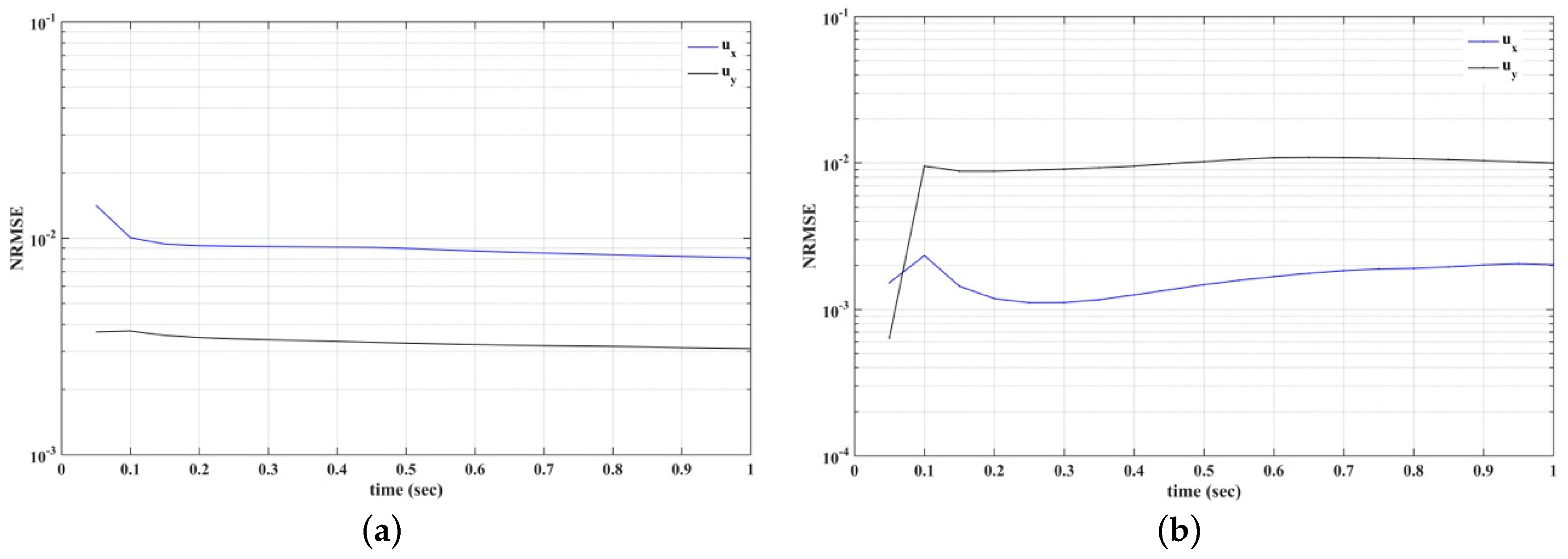To demonstrate the efficiency and accuracy of the proposed numerical scheme, we first apply our method to well-established benchmark problems in computational fluid dynamics, including lid-driven cavity flow, the backward-facing step (BFS), and the unbounded flow past a cylinder.
For all the examples presented here, we examine the accuracy and the efficiency of the proposed scheme for each benchmark problem. Furthermore, we examine the dependence of the critical time step on the grid resolution, Reynolds number and nodes in the support domain. Computations were conducted using an Intel i7 quad core processor with 16 GB RAM.
3.1. Lid-Driven Cavity
Our first example involves incompressible, non-stationary flow in a square cavity (
Figure 1). Despite its geometrical simplicity, the lid-driven cavity flow problem exhibits a complex flow regime, mainly due to the vortices formed in the center and at the corners (bottom left and right, and upper left) of the square domain. We impose no-slip boundary conditions at the bottom and vertical walls (left and right wall), while the top wall slides with unit velocity (
), generating the interior viscous flow.
In most numerical studies on the lid-driven cavity flow problem, the flow regime reaches a steady state solution for Reynolds (
Re) numbers lower than
Re = 10,000. In our study, we report on the results obtained by the proposed scheme for Reynolds numbers
Re = 7500 and 10,000. We consider both uniform Cartesian and irregular nodal distributions. For uniform nodal distributions, our previous studies [
27,
28,
29,
35] show that for Reynolds numbers up to
Re = 10,000, a uniform Cartesian grid with resolution of
captures the forming vortices and provides a grid-independent and accurate numerical solution. In the present study, to highlight the efficiency of the proposed scheme, we use successively finer uniform Cartesian grids, from
to
nodes. We notice that for
Re = 10,000 the
grid resolution can capture all the flow scales and can be used for Direct Numerical Simulation (DNS) studies.
We use the Gershgorin circle theorem to define the critical time step for different nodal distributions (
Table 1 and
Table 2) and for various Reynolds numbers.
Table 1 lists the critical time step computed using the Gershgorin circle theorem for several grid resolutions and different Reynolds numbers (up to
Re = 10,000). For the results reported in
Table 1, 20 nodes were used in the support domain. We further examine the dependence of the critical time step on the number of neighboring nodes in the support domain.
Table 2 lists the critical time step computed using the Gershgorin circle theorem with 40 nodes in the support domain. We can observe that the critical time step increases with the number of nodes in the support domain.
Table 3 lists the computational time (in s) for computing the spatial derivatives for various grid resolutions, and for the numerical solution of N-S equations (for each time iteration) in the case of
Re = 10,000. Recall that we precompute the LU factorization for the discrete Laplacian operator defined for the Poisson type equation for the stream function. Hence, steps 1 and 2 must be performed only once at the beginning of the simulation.
Figure 2 shows the
u- velocity profiles along the vertical line passing through the geometric center of the cavity, and the
v- velocity profiles along the horizontal line passing through the geometric center of the cavity, for
Re = 7500 and 10,000, obtained using the proposed scheme and compared to those reported by Ghia et al. [
42], which are considered as benchmark solution.
Table 3 demonstrates the efficiency of the proposes scheme and its ability to solve relatively large algebraic systems (Poisson equation for stream function) with low computational cost.
We set the Reynolds number to
Re = 10,000 and the total time for the flow simulation to
Tfinal = 250. At that time, the flow regime has all the characteristic features of steady state [
42]. We use a
grid resolution and a time step for the simulations of
.
Figure 3,
Figure 4 and
Figure 5 show stream function and vorticity contours and demonstrate the formation of secondary vortices (
Figure 3 and
Figure 4) which appear as the Reynolds number increases. There are often used as qualitative results, to highlight the accuracy of the numerical method. In detail,
Figure 3 shows the stream function contour plots for
Re = 7500, while
Figure 4 shows the stream function contour plots for
Re = 10,000. Magnified views of the secondary vortices are also included. The stream function values for these contours are listed in
Table 4.
Figure 5 shows the vorticity contours for
Re = 7500 and 10,000. The vorticity values for the contours are listed in
Table 4.
To verify the applicability of the proposed scheme in irregular nodal configurations, we compute the flow regime for
Re = 10,000 using randomly distributed nodes. We use 496,987 nodes to discretize the spatial domain, which provides a grid-independent numerical solution (for the uniform Cartesian grid, a grid independent solution was obtained using a
grid resolution with 160,801 nodes). We obtain the irregular point cloud through a 2D triangular mesh generator (MESH2D-Delaunay-based unstructured mesh-generation). To compare the results with those obtained using the uniform nodal distribution (regular Cartesian grid), we interpolate the velocity, stream function and vorticity values computed using the irregular point cloud onto the uniform nodal distribution using the moving least squares (MLS) approximation method [
43] and compute the maximum normalized root mean square error (NRMSE), defined as [
44],
For all field variables considered, the NRMSE was less than 10−4, which highlights the accuracy of the proposed method for irregular nodal distributions.
We further demonstrate the accuracy of the proposed scheme, providing quantitative results. We use a uniform Cartesian grid of
resolution and we set the time step to
. In
Table 5, we present the strengths and positions of the primary (located in the center of the cavity), secondary (bottom right corner) and ternary vortexes (bottom and top left corners). The numerical results are in excellent agreement with the results reported in Ghia et al. [
42].
Table 6 lists the
u- velocity values along vertical line through the center of cavity, and
Table 7 the
v- velocity values along horizontal line through the center of cavity.
3.2. Backward-Facing Step
The second benchmark problem considered is the backward-facing step [
45]. This problem has been studied by several researchers using different numerical methods and is considered to be a demanding flow problem to solve, mainly due to the flow separation that occurs when the fluid passes over a sharp corner and re-attaches downstream [
1,
45,
46].
Figure 6 shows the spatial domain for the backward facing step. The coordinate system is centered at the step corner, with the
x-coordinate being positive in the downstream direction, and the
y- coordinate across the flow channel. The height
H of the channel is set to
H = 1 (ranging from (0, −0.5) to (0, 0.5)), while the step height and upstream inlet region are set to
H/2. To ensure fully developed flow, the downstream channel length
L is set to
L = 30
H. The inlet velocity has a parabolic profile, with horizontal component
u(
y) = 12
y − 24
y2 for 0 ≤
y ≤ 0.5, which gives a maximum inflow velocity of
umax = 1.5 and average velocity of
uavg = 1. At the outlet, we assume fully developed flow (
du/
dx = 0,
v = 0). The Reynolds number is defined as
Re =
uavgH/
vf, with
vf being the kinematic viscosity.
We first discretize the flow domain with a uniform Cartesian grid. In our previous studies [
29,
35], we have shown that grid with resolution
is sufficient to compute a grid-independent numerical solution for Reynolds numbers up to
Re = 800. As in the previous section, to highlight the efficiency of our scheme, we use a denser grid with resolution
, resulting in 439,230 nodes. We set the total time
Ttotal = 250 (to ensure that the solution will reach steady state), and the time step
dt = 10
−4. The simulation terminates when the NRMSE of the time derivative of the stream function and vorticity field values in two successive time steps is less than 10
−6. The time needed to create the grid was 0.023 s, and it takes 0.3 s to update the solution for each time step. We obtained a steady state solution after 100,000 time steps.
Figure 7 shows the stream function and vorticity contours for
Re = 800. The flow separates at the step corner and vortices are formed downstream. We can observe the two vortices formed at the lower and upper wall. After reattachment of the upper wall eddy, the flow in the duct slowly recovers towards a fully developed flow. We compute the separation and reattachment points at
Llower ≈ 6.1 for the lower wall separation zone,
Lupper ≈ 5.11 for the upper separation zone, where the separation begins at
x ≈ 5.19. Our numerical findings show good agreement with other numerical methods for 2D computations [
1,
46]. In [
1], the authors used a finite difference method and predicted separation lengths of
Llower ≈ 6.0 and
Lupper ≈ 5.75, while [
46] using the A Fluid Dynamics Analysis Program (FIDAP) code (Fluid dynamics International Inc., Evanston, IL, USA) predicted
Llower ≈ 5.8 and the upper
Lupper ≈ 4.7.
Figure 8 shows the comparisons of the
u- and
v- velocity components and vorticity values, between the present scheme and those obtained using the finite element method (FEM) [
45], along the line
x = 7 and
x = 15 for
Re = 800. Additionally, we computed the shear stress, defined as
on the lower and upper wall, for increasingly refined nodal resolution.
Figure 9a shows plots of the shear stress for the upper and lower wall, while
Figure 9b displays the convergence of the upper wall shear stress when successively denser point clouds are used. We can see that shear stress converges and is accurate when compared to results of [
45]. The accurate computation of spatial derivatives is a particular advantage of the strong form meshless method. In contrast, convergence of many finite element methods can be obtained only in terms of integral norms, and the point-wise convergence for the velocity gradient cannot be guaranteed even in the case of a smooth numerical solution [
47].
Table 8 and
Table 9 list the velocity and vorticity field values at the at
x = 7 and
x = 15, respectively, for
Re = 800.
3.3. Unbounded Flow Past a Cylinder
We examine the case of external flow past a circular cylinder in an unbounded domain [
48]. The flow domain is large compared to the dimensions of the cylinder, as shown in
Figure 10. The cylinder cross-section has a radius
Rc = 0.5 and is located at the origin
O (0,0) of a square domain with dimensions
and
.
The uniform flow is not perturbed near the inlet, which is far from the body. Therefore, we assume that the inflow velocity
uinlet behaves like the potential flow
upotential given as:
or in terms of the stream function:
The boundary conditions for the stream function and vorticity on the remaining boundaries (the top and bottom wall, outlet and cylinder surface) are:
At the inlet, top and bottom walls (
B = inlet, top and bottom)
On the cylindrical surface
We represent the flow domain with a uniform Cartesian embedded grid, locally refined in the vicinity of the cylinder (
Figure 11a). We use 402,068 nodes (0.5 s to create the nodal distribution) and we set Reynolds number to
Re = 40. We use a time step of
for the entire flow simulation. It takes 0.3 s to update the solution for each time step, and we obtained a steady state solution after 20,000 time steps. The spatial derivatives (up to 2nd order) are computed in 4.24 s using a C++ code. Additionally, we solve the flow problem using an irregular nodal distribution with 221,211 nodes, locally refined in the vicinity of the cylinder.
We compute the following flow parameters: the pressure coefficient (
Cp) on the body surface, the length (
L) of the wake behind the body, the separation angle (
θs), and the drag coefficient (
CD) of the body. The drag and lift coefficient of the body are given by:
where
D is the characteristic length of the body,
and
are the unit normal vector in
x- and
y- direction, respectively, and
is the total drag force acting on the body. The total drag force is given as:
where
, the pressure drag, can be determined from the flux of vorticity on the surface of the cylinder as:
The friction drag
may be computed from the vorticity on the surface of the body as:
with
.
Table 5 lists the recirculation length (
Lrec) of the wake behind the body, the separation angle (
θs), and the drag coefficient (
CD) for
Re = 40.
The numerical findings obtained by the proposed scheme are listed in
Table 10, and are in good agreement with those in the literature [
48,
49,
50,
51]. The stream function and vorticity contours around the cylinder are illustrated in
Figure 12 (as in [
48]).

